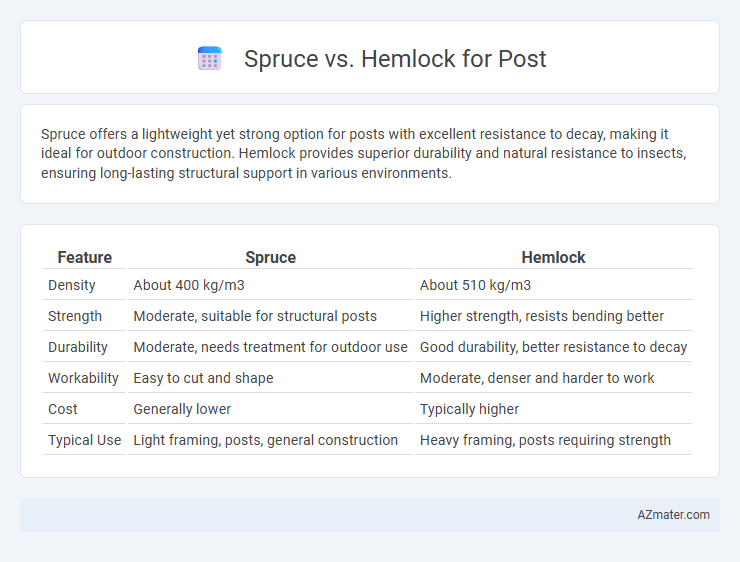Spruce offers a lightweight yet strong option for posts with excellent resistance to decay, making it ideal for outdoor construction. Hemlock provides superior durability and natural resistance to insects, ensuring long-lasting structural support in various environments.
Table of Comparison
| Feature | Spruce | Hemlock |
|---|---|---|
| Density | About 400 kg/m3 | About 510 kg/m3 |
| Strength | Moderate, suitable for structural posts | Higher strength, resists bending better |
| Durability | Moderate, needs treatment for outdoor use | Good durability, better resistance to decay |
| Workability | Easy to cut and shape | Moderate, denser and harder to work |
| Cost | Generally lower | Typically higher |
| Typical Use | Light framing, posts, general construction | Heavy framing, posts requiring strength |
Introduction to Spruce and Hemlock as Post Materials
Spruce and hemlock are popular timber choices for posts due to their strength and durability in outdoor applications. Spruce offers excellent dimensional stability with a fine grain structure, making it resistant to warping and ideal for structural posts. Hemlock, known for its dense fiber composition and natural resistance to decay, provides robust support and longevity in ground-contact posts.
Physical Characteristics: Spruce vs Hemlock
Spruce wood exhibits a lighter color with a fine, even grain and a relatively softer texture compared to Hemlock, which has a coarser grain and a slightly reddish-brown hue. Hemlock posts tend to be denser and more resistant to splitting, making them ideal for structural support where strength is crucial. Spruce, with its uniform appearance and moderate strength, is often preferred for applications requiring easier workability and a smooth finish.
Durability and Longevity Comparison
Spruce posts offer moderate durability, with natural resistance to decay limited compared to hemlock, requiring treatment for outdoor use. Hemlock is more durable and denser, providing better longevity, especially when properly treated against moisture and pests. Both woods benefit from preservative treatments, but hemlock's superior strength and decay resistance often make it the preferred choice for long-lasting structural posts.
Resistance to Decay and Insects
Spruce offers moderate resistance to decay and insects, making it less durable for outdoor posts without pressure treatment. Hemlock naturally resists decay and insect damage better than spruce, providing longer-lasting performance for posts exposed to moisture and pests. Choosing hemlock for posts ensures enhanced durability and reduced maintenance in outdoor applications.
Strength and Load-Bearing Capacities
Spruce offers a higher strength-to-weight ratio compared to Hemlock, making it a preferred choice for posts requiring superior load-bearing capacity. Hemlock, while still strong, has slightly lower tensile strength and is more prone to bending under heavy loads. For structural applications where durability and maximum support are critical, Spruce posts provide enhanced stability and longer lifespan under stress.
Workability and Ease of Handling
Spruce offers excellent workability with its straight grain and uniform texture, making it easy to saw, plane, and nail when used for posts. Hemlock is slightly harder and denser than spruce, requiring more effort to cut and shape but still manageable with standard woodworking tools. Both woods handle well for outdoor posts, though spruce's lighter weight and softness provide a slight advantage in ease of handling and installation.
Cost and Availability
Spruce posts generally cost less than hemlock due to their faster growth rates and more abundant supply, making them a budget-friendly option for fencing and construction projects. Hemlock offers greater durability and resistance to decay but tends to be more expensive and less readily available in certain regions. Choosing between spruce and hemlock posts depends on balancing initial cost savings with long-term performance and local market availability.
Environmental Impact and Sustainability
Spruce and hemlock both offer sustainable forestry options, but spruce generally has a faster growth rate leading to shorter carbon sequestration cycles, which can reduce long-term environmental impact. Hemlock is more resistant to decay and pests, potentially extending the lifespan of posts and reducing the frequency of replacements and resource consumption. Choosing locally sourced wood for posts ensures lower transportation emissions and supports sustainable forest management practices.
Common Applications for Spruce and Hemlock Posts
Spruce posts are widely used in construction for framing, fencing, and utility poles due to their strength, lightweight nature, and affordability. Hemlock posts are preferred in landscaping, decking, and outdoor structures because of their superior durability, resistance to decay, and smooth finish. Both Spruce and Hemlock offer excellent structural support, but Hemlock is better suited for applications requiring enhanced weather resistance.
Choosing the Right Wood: Spruce or Hemlock for Your Project
Spruce offers a lightweight, cost-effective option with good strength and straight grain, making it ideal for framing and posts requiring ease of handling and quick installation. Hemlock provides superior durability, resistance to decay, and a fine, uniform texture, making it suitable for structural posts exposed to harsh weather conditions. Selecting between spruce and hemlock depends on the project's load-bearing needs, environmental exposure, and budget constraints.

Infographic: Spruce vs Hemlock for Post
 azmater.com
azmater.com